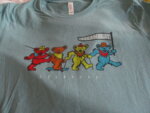Pointless Prize: Civil War History
Our Community › Forums › Freezing Saddles Winter Riding Competition › Pointless Prize: Civil War History
- This topic has 266 replies, 23 voices, and was last updated 4 years, 2 months ago by
 AlanA.
AlanA.
-
AuthorPosts
-
January 31, 2021 at 5:20 pm #1110677
bikesnick
ParticipantJefferson Finis Davis was president of the Confederate States of America.
Before the civil war, he served in the US Senate and House, representing Mississippi, and as US Secretary of War.
He married a daughter of future President Zachary Taylor, although she died from malaria, six months later.
After capture in 1865, he was imprisoned and accused of treason, but never was tried and was released after two years.
President Andrew Johnson pardoned him in 1868.Davis Court (McLean, VA)
[ATTACH=CONFIG]23545[/ATTACH]February 1, 2021 at 10:20 pm #1110755bikesnick
ParticipantAaron Anderson was an African American Medal of Honor winner for heroic actions serving in the US Navy during the Civil War.
He helped maneuver a gun boat to safety during an attack by Confederate soldiers.Anderson Road in McLean, VA
[ATTACH=CONFIG]23566[/ATTACH]February 2, 2021 at 10:46 pm #1110819bikesnick
ParticipantJohn Lawson was an African American sailor for the US Navy during the Civil War.
He received the Medal of Honor for continuing to supply gunners despite being seriously wounded.Lawson Lane (McLean, VA)
[ATTACH=CONFIG]23599[/ATTACH]February 3, 2021 at 12:12 am #1110831consularrider
ParticipantWho’s buried here (and not under the snow)?
[ATTACH=CONFIG]23607[/ATTACH]
February 3, 2021 at 7:39 pm #1110870matteblack
Participant@consularrider 206919 wrote:
Who’s buried here (and not under the snow)?
I’m going to go out on a limb and say U.S. Grant. :p
That being said, I heard at one point this was the most visited attraction in NYC and went off in search of a source to back it up. I quickly gave up because I have things to do, but not before I came across this gem (from the wikipedia, so take it with a grain of salt):
The sarcophagi [of Grant and his wife] are placed above ground, leading to a common riddle by comedian Groucho Marx, who often asked contestants on his radio and television quiz show You Bet Your Life: “Who was buried in Grant’s Tomb?” The riddle is based on the use of the word “buried”, and since neither of the Grants’ tombs are underground, the correct answer is “no one”. However, Marx often accepted the answer “Grant” and awarded a consolation prize to those who gave it. He used the question, among several other easy ones, to ensure that everyone won a prize on the show.
February 3, 2021 at 9:28 pm #1110873 Boomer CyclesParticipant
Boomer CyclesParticipant#civilwarmarker – Freedom Hill

Freedom Hill is located in Tysons Corner off Old Courthouse Road in the Freedom Hill Park. It was a fortified gunpit made of earth and wood and part of the original Defenses of Washington. It was a standard army design with a gun platform and surrounding earth walls lined with timber. It was built early in 1865 in response to Confederate activity in the area and to protect a signal tower at nearby Peach Grove Stockade. Per historic records it saw no significant activity during the Civil War.
Sent from Boomer_Cycles via my iPhone using Tapatalk
February 3, 2021 at 9:44 pm #1110878bikesnick
ParticipantWilliam A. Jackson was a freed slave and provided intelligence for the Union during the Civil War.
He escaped and passed on high-level Confederate military details that he learned while a slave in the home of Confederate president Jefferson Davis.N. Jackson Street (Arlington, VA)
[ATTACH=CONFIG]23619[/ATTACH]February 3, 2021 at 11:46 pm #1110892josh
Participant@bikesnick 206966 wrote:
William A. Jackson was a freed slave and provided intelligence for the Union during the Civil War.
He escaped and passed on high-level Confederate military details that he learned while a slave in the home of Confederate president Jefferson Davis.N. Jackson Street (Arlington, VA)
Out of curiosity, are all these street names known to be related to these Civil War people, or is it just a hopeful assumption? Names like Monitor and Merrimack are obvious, but I’d always assumed that ones like Truman or Jackson were named after presidents. While trying to figure out some of these name origins, I did learn about the great Arlington street renaming of 1932, and how a County committee created a unifying naming scheme for the county’s formerly ragtag, disparate streets.
February 4, 2021 at 12:53 am #1110909 AlanAParticipant
AlanAParticipant@josh 206980 wrote:
Out of curiosity, are all these street names known to be related to these Civil War people, or is it just a hopeful assumption? Names like Monitor and Merrimack are obvious, but I’d always assumed that ones like Truman or Jackson were named after presidents. While trying to figure out some of these name origins, I did learn about the great Arlington street renaming of 1932, and how a County committee created a unifying naming scheme for the county’s formerly ragtag, disparate streets.
After seeing all these random roads in this thread, I did a search for a street name followed by ‘civil war’. You find a lot of silly random references. But, you do learn something new after doing that search. It’s sort of stupid fun and a learning experience.
February 4, 2021 at 3:31 am #1110916BicycleBeth
Participant@josh 206980 wrote:
Out of curiosity, are all these street names known to be related to these Civil War people, or is it just a hopeful assumption? Names like Monitor and Merrimack are obvious, but I’d always assumed that ones like Truman or Jackson were named after presidents. While trying to figure out some of these name origins, I did learn about the great Arlington street renaming of 1932, and how a County committee created a unifying naming scheme for the county’s formerly ragtag, disparate streets.
Hi Josh,
For this game, we don’t need to prove provenance for the street name. Alan A asked this question awhile ago and I bet the answer is buried in week 1 of our posts. The most important thing for this Pointless Prize is for players to learn about the history of the Civil War rather than the history of how a street got its name (also interesting but not well-documented in many cases).
I hope that helps clarify things.
 February 4, 2021 at 10:19 pm #1110959
February 4, 2021 at 10:19 pm #1110959bikesnick
ParticipantAbraham Galloway, an escaped slave, spied for the Union Army during the Civil War. He travelled throughout the South, acting as a slave, but actually was collecting intelligence on Confederate troops and encouraging slaves to join the Union. In 1864 he was part of a delegation that met with President Lincoln. After the war, he continued abolitionist and women’s suffragist efforts, and served in the North Carolina senate.
Galloway Drive (Vienna, VA)
[ATTACH=CONFIG]23660[/ATTACH]February 6, 2021 at 3:23 am #1111071bikesnick
ParticipantBlanche K. Bruce, born into slavery, attended and taught at Oberlin College and represented Mississippi as a US senator during the Reconstruction Era. He was the first African American to serve a full term in the US Senate and the first African American (and only former slave) to preside over the Senate. His home, in the Shaw neighborhood of DC, is a National Historic Landmark. A DC public school, named in his honor in 1898, is now called Caesar Chavez Prep Middle School.
Bruce St in Alexandria, VA
[ATTACH=CONFIG]23717[/ATTACH]February 6, 2021 at 10:02 pm #1111099bikesnick
ParticipantJohn Noland, a former Missouri slave, was a Confederate scout during the Civil War. After a pro-Union militia destroyed his home, he joined a pro-Confederate militia. The militia, led by William Quantrill, was a guerrilla band noted for brutal tactics. (Jesse James and his brother were part the group.) John refused a Union offer of money to betray Quantrill. He attend most of the reunions of Quantrill’s Raiders after the war.
Noland Street (Falls Church, VA)
[ATTACH=CONFIG]23738[/ATTACH]February 7, 2021 at 3:24 am #1111144Catedrew
Participant#CivilWarMarker – Freedman’s Village, SouthGate Road & South Oak Streets, Arlington, VA. Located at Foxcroft Heights Park, This is the inscription on the sign:
After the outbreak of the Civil War, escaped slaves sought refuge at Union Camps and thousands crowded into the Federal City. In response to the unhealthy conditions in Washington, the government selected a site on Arlington Heights in May, 1863, to provide freed slaves with housing and opportunities for work, training and education. Freedman’s Village, which was located in Arlington National Cemetery, was soon built and formally dedicated on December 4, 1863. There were over 50 two-story duplex houses, two churches, a school, a meeting hall, hospital and home for the aged and infirm. In time the population exceeded 1,000. Though intended to be temporary, the village lasted into the 1890s, when it was closed and its residents dispersed.
[ATTACH=CONFIG]23768[/ATTACH]
[ATTACH=CONFIG]23769[/ATTACH]
[ATTACH=CONFIG]23770[/ATTACH]
[ATTACH=CONFIG]23771[/ATTACH]
February 7, 2021 at 6:49 am #1111161bikesnick
ParticipantRobert John Simmons, born in Bermuda, enlisted and was promoted to First Sergeant with the 54th Massachusetts Volunteer Infantry Regiment during the Civil War. This regiment fought at Fort Wagner and was depicted in the film Glory. Simmons was wounded, captured and died.
Simmons Drive (McLean, VA)
[ATTACH=CONFIG]23782[/ATTACH] -
AuthorPosts
- You must be logged in to reply to this topic.